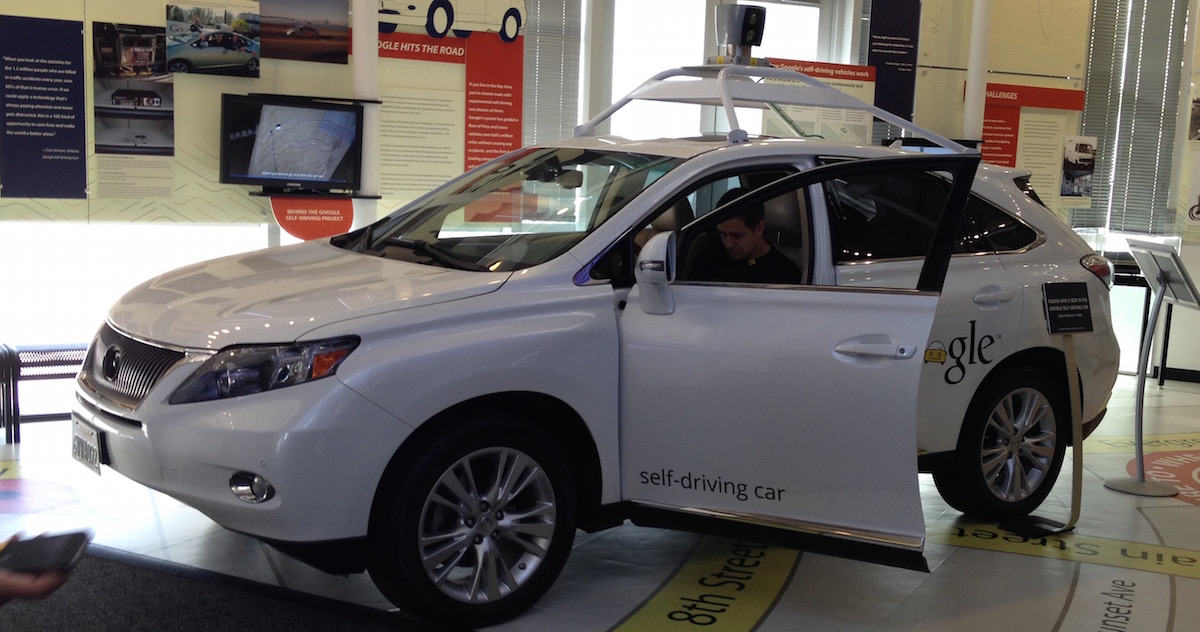
Category: Automotive, Self-driving
Mar 19
Google’s ‘Self-Driving Car as a Service’ will be in every car
When you live in Mountain View, Google’s self-driving cars are a common view. The white Lexus SUVs with ever changing sensors sticking out on both sides and a LIDAR-system – either a rotating “pot” or most recently a glass-covered half-dome – on the roof, keep roaming the city to gather experience in different traffic situations.
I effectively stopped taking and posting pictures of videos of my encounters with the cars, as my Facebook friends let me know that it started annoying them. Which of course contributes to the overall traffic safety, as this is one of the most common – and dangerous – things that drivers of other cars do: getting their phones out and snapping pictures while driving.
But I am getting distracted. The questions is: is Google really going to build and sell self-driving cars, and if yes, why?
To answer this question, let me go back to the time when Google launched Google Maps. When I first saw Google Maps, I couldn’t wrap my mind around why Google would do a mapping service. After all, Google’s mission was to collect and make information accessible. What does a map service have to do with this?
The answer came after I saw the first use of the Google Map API. A real estate company had put markers on Google Maps listing their open houses. And that made it so obvious. Google just had made the step from virtual world information to real world information.
As a search engine, Google’s bots had crawled websites to collect information and bring it back to Google’s servers. With Google Maps the virtual information could be merged with real world information. Location information such as addresses of restaurants, schools, parks and many other things popped up on maps. And then Google Street View enhance the offering. Cars, bikes, bag packs, and even diving sets equipped with cameras roamed the streets and planet to collect images of the real world. Even more information was put on the maps and mashed with other information.
Those Street View cars became the real world bots. Instead of websites they crawled the cities and countryside and returned with their information to make it accessible. Which turned out to be of tremendous value for us. We can experience foreign countries and continents, and people with handicaps can virtually check out stores and other locations whether they can access them or not and make necessary arrangements.
But Street View cars are labor intensive. The obvious step is to automate those real world bots and transform them into autonomous vehicles and robots. That automates the collection of information and give a more accurate and timely update on changes in the real world. that makes it clear why Google builds autonomous vehicles and buys robotic companies.
But what does that mean for Google X self-driving cars? Is Google going full fledged into the car business, designing, building, and selling cars?
Very likely not. It’s not Google’s core business. The core business is still operating an information gathering and providing service. But Google has all the pieces in place to equip any car. Data crunching algorithms, mapping services, geo-location, hundred of thousands of miles driven with thecars, and tons of more information.
Given that most modern cars already come equipped with hundreds of sensors and microchips, hooking in a box containing “Google Self-Driving Car as a Service” can upgrade every car to a self-driving vehicle. The traditional car makers, which today are far behind Google’s autonomous vehicle development, would save huge investment costs and level the playing field for all.
What does Google get out of that? Part of the deal could be that Google will get access to the data that their service generates. Simply by having the Google X Self-driving car box in every car would make huge amounts of current real world information available.
How much will the box cost? Nothing! That’s the beauty. Once the development has reached a certain state, the software and information would be free. The business model of building the hardware components of the box would be similar to building laptops. The money in building laptops is in the additional maintenance services that are sold around it, not in selling the laptops. For Google the money is in getting the information that they can use to provide better information and benefit from better targeted ads.
But why even a box? Google Self-Driving Car as a Service could be nothing else than a smartphone app. Connecting your phone to the car and off we go. The computing power and connectivity is already today in your pocket.
And that is just the beginning. The sharing economy, taxi services, and logistics industry would dramatically change and benefit from a fleet of cars equipped with Google’s box. Cars could pick up my child, items bought in a store, and park themselves. For traditional car manufacturers this means to be amongst the first to partner with Google. The world of driving is changing significantly. And you don’t want to become the Blackberry of cars.
I for sure am looking forward to autonomous vehicles. Having to drive a car is for me the ultimate waste of time. And I hope that the time will come soon that we consider human driven cars as what they are: irresponsible and dangerous.
This article was first posted on LinkedIn.

Recent Comments